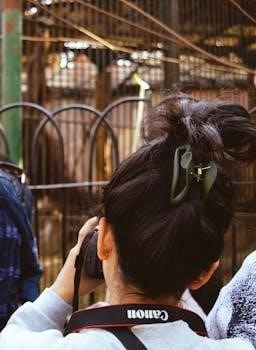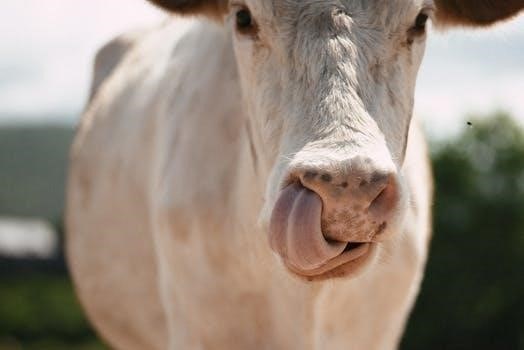
Click Clack Moo⁚ Cows That Type ⎻ An Overview
“Click‚ Clack‚ Moo⁚ Cows That Type” is a delightful children’s book by Doreen Cronin‚ showcasing cows who discover a typewriter and use it to communicate their demands‚ leading to humorous farmyard negotiations and a strike for electric blankets.
Doreen Cronin’s “Click‚ Clack‚ Moo⁚ Cows That Type” introduces a world where farm animals possess unexpected literacy. The story begins with the cows discovering an old typewriter in the barn. This discovery sets off a chain of events that disrupt the tranquility of Farmer Brown’s farm. The cows‚ using their newfound skill‚ begin typing letters to Farmer Brown‚ initiating a series of demands. The initial request for electric blankets leads to a humorous and engaging conflict between the farmer and his increasingly assertive bovine residents.
Characters and Setting
The story features Farmer Brown‚ the cows‚ hens‚ and a duck‚ set on a farm where the barn becomes the central location. This setting amplifies the narrative about communication and negotiation.
Farmer Brown
Farmer Brown is the owner of the farm and represents the authority figure. He is initially bewildered and then frustrated by the cows’ newfound ability to type and make demands. Farmer Brown’s character embodies resistance to change and a traditional view of farm life. His reactions to the cows’ notes and subsequent strike drive much of the conflict in the story‚ highlighting themes of negotiation and compromise. Despite his initial reluctance‚ Farmer Brown eventually engages in a dialogue with the animals‚ demonstrating a capacity for adaptation‚ though not without considerable exasperation and a touch of humor.
The Cows‚ Hens‚ and Duck
The cows are the central instigators of the story’s events‚ discovering a typewriter and using it to voice their desire for electric blankets. They exemplify collective action and assertiveness‚ challenging the established farm hierarchy. The hens‚ though less vocal‚ support the cows’ strike‚ showcasing solidarity among the farm animals. The duck serves as a neutral mediator‚ facilitating communication between the cows and Farmer Brown. This character’s role is crucial in resolving the conflict‚ highlighting the importance of diplomacy and understanding in resolving disputes. Each animal plays a vital role in the unfolding narrative.
The Barn as a Central Location
The barn functions as the epicenter of activity in “Click‚ Clack‚ Moo⁚ Cows That Type‚” serving as both the cows’ living space and the location where they discover the typewriter. This space transforms into a hub of communication and negotiation as the cows begin typing their demands. It symbolizes the cows’ collective voice and their challenge to Farmer Brown’s authority. The barn becomes a site of rebellion and negotiation‚ emphasizing the importance of shared spaces in fostering communication and community‚ even when those spaces become stages for conflict and resolution between animals and humans.

The Plot⁚ Cows’ Demands and Farmer Brown’s Reaction
The cows’ discovery of a typewriter leads to demands for electric blankets. Farmer Brown initially refuses‚ sparking a strike. Negotiations ensue‚ highlighting themes of communication and compromise in this humorous tale.
The Discovery of the Typewriter
The pivotal moment in “Click‚ Clack‚ Moo⁚ Cows That Type” arrives when the cows stumble upon an old typewriter in the barn. This discovery empowers them with a means of written communication. They begin to articulate their needs and desires‚ moving beyond simple mooing; The typewriter becomes a symbol of their newfound voice. It allows them to express dissatisfaction with the cold barn conditions‚ setting the stage for their subsequent demands and the ensuing conflict with Farmer Brown. This simple machine sparks a revolution on the farm‚ changing the dynamic between farmer and animals.
The Demand for Electric Blankets
Leveraging their newfound ability to type‚ the cows formally present Farmer Brown with their first demand⁚ electric blankets. Their typed note clearly outlines the issue – the barn is cold at night. This request isn’t delivered through moans or gestures but via a typed‚ written communication. The electric blankets represent more than just warmth; they symbolize the cows’ desire for improved conditions and their willingness to advocate for themselves. This bold request immediately escalates the situation‚ setting the tone for a negotiation between the cows and a bewildered‚ and soon to be furious‚ Farmer Brown.
The Strike and Negotiations
Upon Farmer Brown’s refusal to provide the electric blankets‚ the cows initiate a full-blown strike‚ ceasing milk production. This action is a direct consequence of their unmet demands‚ showcasing their collective power. The hens‚ in solidarity‚ join the strike‚ halting egg production‚ further compounding Farmer Brown’s problems. A neutral party‚ Duck‚ emerges as a mediator‚ facilitating communication between the cows and the frustrated Farmer Brown. Through typed notes and Duck’s diplomacy‚ they eventually negotiate a compromise⁚ the cows will receive electric blankets in exchange for their typewriter‚ restoring peace and productivity to the farm.

Themes and Literary Devices
The story utilizes humor and absurdity to explore themes of communication‚ negotiation‚ and fairness. Repetition of “Click‚ Clack‚ Moo” creates a memorable sound effect‚ enhancing the story’s playful and engaging nature for young readers.
Humor and Absurdity
The core appeal of “Click‚ Clack‚ Moo⁚ Cows That Type” lies in its delightful blend of humor and absurdity. The very premise of cows operating a typewriter is inherently funny‚ creating a world where farm animals engage in human-like activities and negotiations. This whimsical scenario is amplified by the cows’ specific demands for electric blankets‚ further highlighting the story’s playful nature. Farmer Brown’s increasingly exasperated reactions to the cows’ typed requests add another layer of comedic effect‚ making the story enjoyable for both children and adults. The unexpected strike and subsequent negotiations contribute to the overall lighthearted and entertaining tone of the book.
Communication and Negotiation
“Click‚ Clack‚ Moo⁚ Cows That Type” cleverly explores themes of communication and negotiation. The cows use the typewriter as a tool to express their needs and desires to Farmer Brown‚ initiating a dialogue that challenges the traditional farm dynamic. Their typed demands force Farmer Brown to engage in a form of negotiation‚ albeit reluctantly. The story highlights the importance of clear communication in resolving conflicts‚ even when the parties involved are as different as a farmer and his cows. The duck acts as a mediator‚ facilitating the exchange of messages and highlighting the power of diplomacy in reaching a resolution that satisfies both sides.
Repetition and Sound Effects (“Click‚ Clack‚ Moo”)
The charm of “Click‚ Clack‚ Moo⁚ Cows That Type” is significantly enhanced by the effective use of repetition and sound effects. The phrase “Click‚ Clack‚ Moo‚” mimicking the sound of the typewriter‚ becomes a memorable and rhythmic refrain throughout the story. This repetition not only adds to the book’s auditory appeal but also emphasizes the cows’ persistent efforts to communicate. The onomatopoeic sounds create a vivid soundscape that immerses young readers in the story‚ making it an engaging and interactive experience. The consistent use of these sound effects reinforces the central theme of communication and adds a layer of humor to the narrative‚ making it appealing to children of all ages.

Educational Value and Activities
“Click‚ Clack‚ Moo” offers educational opportunities‚ from reading comprehension to animal sounds. Activities can include creative writing prompts‚ exploring onomatopoeia‚ and discussions about communication and negotiation skills for young learners.
Reading Comprehension and Vocabulary
“Click‚ Clack‚ Moo⁚ Cows That Type” provides a rich context for enhancing reading comprehension skills in children. The story’s clear narrative structure and engaging plot make it ideal for practicing sequencing events and identifying the main idea. Teachers can use the book to explore cause-and-effect relationships within the story‚ prompting students to analyze Farmer Brown’s reactions to the cows’ demands.
Vocabulary development is another key area where “Click‚ Clack‚ Moo” shines. The text introduces children to new words like “furious‚” “demand‚” and “negotiate‚” encouraging them to expand their lexicon. Through context clues and discussions‚ students can infer the meanings of unfamiliar words‚ strengthening their overall reading proficiency.
Animal Sounds and Onomatopoeia
“Click‚ Clack‚ Moo⁚ Cows That Type” is a fantastic resource for exploring animal sounds and the literary device of onomatopoeia. The book prominently features the sounds of farm animals‚ such as the cows’ “moo‚” enhancing the story’s auditory appeal and engaging young readers.
The repeated use of “click‚ clack‚ moo” throughout the narrative exemplifies onomatopoeia‚ where words imitate sounds. This repetition not only creates a memorable rhythm but also helps children understand how language can mimic real-world noises. Teachers can use this book to introduce and reinforce the concept of onomatopoeia‚ encouraging students to identify other examples of sound words and create their own.
Creative Writing and Storytelling
“Click‚ Clack‚ Moo⁚ Cows That Type” serves as an excellent springboard for creative writing and storytelling activities. The book’s whimsical premise of cows using a typewriter can inspire children to imagine their own scenarios involving animals with human-like abilities. Students can create stories about other farm animals making demands or even invent new technologies for the animals to use.
The book also encourages exploration of different perspectives‚ such as Farmer Brown’s frustration or the cows’ determination. Teachers can prompt students to write from the point of view of different characters‚ fostering empathy and enhancing their storytelling skills. Furthermore‚ the book’s engaging plot structure provides a model for crafting their own narratives.

Adaptations and Related Resources
Numerous adaptations and resources exist for “Click‚ Clack‚ Moo‚” including PDF scripts for plays‚ online lesson plans‚ and puppet show guides. These materials enhance the story’s educational impact and provide creative learning opportunities for educators and students.
PDF Scripts and Online Resources
For educators and parents seeking to extend the “Click‚ Clack‚ Moo” experience‚ numerous PDF scripts are available online‚ enabling engaging classroom plays or home performances. These scripts often include character dialogue and narration‚ fostering reading comprehension and dramatic skills. Additionally‚ various online resources offer lesson plans‚ study guides‚ and interactive activities centered around the book’s themes. These materials delve into communication‚ negotiation‚ and problem-solving‚ promoting critical thinking. Websites provide vocabulary exercises‚ comprehension quizzes‚ and creative writing prompts‚ enhancing the book’s educational value. Teachers can find diverse tools to integrate “Click‚ Clack‚ Moo” into their curriculum effectively.
Puppet Show Activities
“Click‚ Clack‚ Moo⁚ Cows That Type” readily lends itself to engaging puppet show adaptations‚ offering a creative and interactive way to explore the story’s themes. Students can craft their own cow‚ hen‚ and duck puppets‚ enhancing their artistic skills and fostering imaginative play. By performing the story through puppets‚ children develop their storytelling abilities‚ practice character voices‚ and deepen their understanding of the narrative. Creating a simple barn backdrop further enhances the experience. Puppet show activities encourage collaboration‚ communication‚ and problem-solving as students work together to bring Farmer Brown’s farm to life‚ fostering teamwork and creativity.
Lesson Plans and Study Guides
Numerous lesson plans and study guides are available to enhance the educational value of “Click‚ Clack‚ Moo⁚ Cows That Type” in the classroom. These resources often include activities focused on reading comprehension‚ vocabulary development‚ and character analysis. Worksheets may prompt students to identify the main idea‚ sequence events‚ and explore the themes of communication and negotiation. Creative writing prompts encourage students to imagine alternative scenarios or write letters from the perspective of different characters. Study guides often incorporate discussions about animal sounds‚ onomatopoeia‚ and the use of repetition in the story‚ fostering critical thinking and language skills.